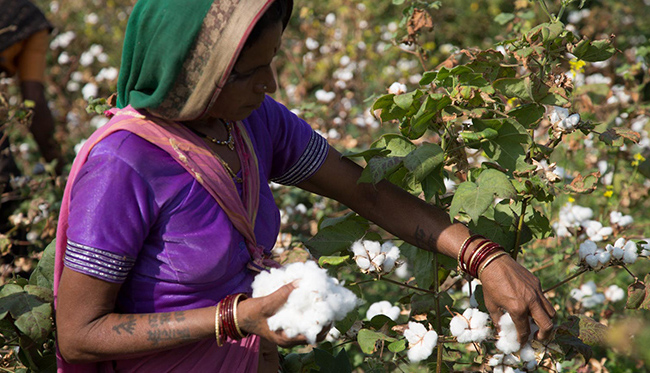Social, Economic, and Environmental Impact Assessment of Cotton Farming in Madhya Pradesh, India

Images courtesy of Dinesh Khanna for C&A Foundation
Worldwide demand for cotton products that meet certification standards—organic, fair trade, etc.—has grown over the past 10 years. India is the largest producer of cotton in the world.
As of 2016-17, India produced 5.88 million metric tons of cotton and exported 1.26 million metric tons. India is also the largest producer of organic cotton, accounting for 56% of the world’s production. This includes organic cotton produced as part of the Better Cotton Initiative (BCI), a subset of organic cotton farmers who adhere to less restrictive standards on crop inputs but more restrictive social and labor standards than those of organic cotton, including promoting decent work practices.
The Study
 AIR—funded by the C&A Foundation and in partnership with Outline India and Thinkstep India—conducted a social and economic impact assessment, and contributed to an environmental impact assessment of cotton farming in Madhya Pradesh, a central Indian state and the largest organic cotton producer in the country. This mixed methods study aims to better understand the socioeconomic and environmental outcomes of organic and BCI cotton farming, compared with conventional cotton farming. The research team examined outcomes of five subgroups of cotton farmers:
AIR—funded by the C&A Foundation and in partnership with Outline India and Thinkstep India—conducted a social and economic impact assessment, and contributed to an environmental impact assessment of cotton farming in Madhya Pradesh, a central Indian state and the largest organic cotton producer in the country. This mixed methods study aims to better understand the socioeconomic and environmental outcomes of organic and BCI cotton farming, compared with conventional cotton farming. The research team examined outcomes of five subgroups of cotton farmers:
- Conventional (non-organic)
- Exclusive organic (farmers only producing organic cotton)
- Exclusive BCI (farmers only producing BCI cotton)
- Non-exclusive organic (farmers producing both organic and conventional cotton)
- Non-exclusive BCI (farmers producing both BCI and conventional cotton)
Results
Results from the impact assessment reports include:
- Both organic and BCI farmers are socioeconomically better off than conventional farmers—they’re more likely to own a color television, refrigerator, computer, concrete or tiled roof, livestock, and more.
- On average, exclusive organic cotton farmers use 66 days of family labor and 430 days of wage labor, while non-exclusive organic cotton farmers use 114 days of family labor and 524 days of wage labor.
- On average, exclusive BCI farmers use 97 days of family labor and 584 days of wage labor, while non-exclusive BCI farmers use 93 days of family labor and 506 days of wage labor.
- Organic farmers are more likely to be in debt and have higher debts than conventional farmers; of the organic farmers, 93 percent reported at least one household member having a loan. This is compared with 84 percent of conventional cotton farmers.
- BCI farmers are more likely to be to be in debt and have higher debts than conventional farmers; of the BCI farmers, 89 percent reported at least one household member with a loan. This is compared with 84 percent of conventional cotton farmers.
- Some evidence suggests that BCI farmers are less likely to use child labor than conventional farmers. Of farmers licensed by BCI with children ages 6 to 14 years old, 98 percent reported that the children are enrolled in school, compared with 95 percent in conventional cotton farming households.
- On average, exclusive organic farmers, non-exclusive organic farmers, and conventional farmers all saw a loss on their cotton production between 2017 and 2018, but a substantial percentage of the farmers made a profit.
